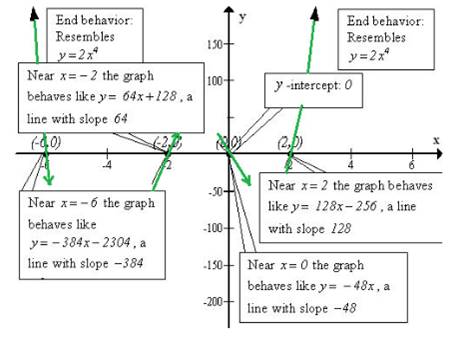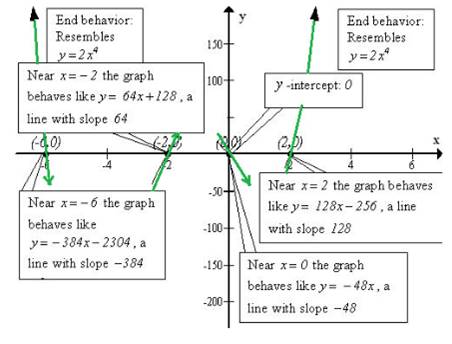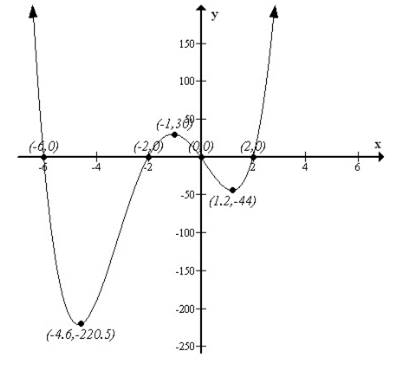
Concept explainers
To analyze: the given polynomial function
Answer to Problem 99AYU
Figure 1(a):

Figure 1(b):

Explanation of Solution
Given:
Calculation:
Let us consider the function
This polynomial function
Step1: Determine the end behavior of the graph of the function
Expand the polynomial to write it in the form
The polynomial function f is of degree 4. The graph of f behaves like
Step2: find the x -and y -intercepts of the graph of the function
Substitute
The y -intercept is
To find the x -intercepts, solve
If and only if any of the factors is zero.
So,
Step3: Determine the zeros of the function and their multiplicity. Use this information to determine whether the graph crosses or touches the x -axis at each x -intercept.
The zeros or roots of fare obtained from
That is
The root-6is a zero of multiplicity 1, so the graph off crosses the x -axis at
The root -2 is a zero of multiplicity1. So the graph of f crosses thex -axis at 2nd time.
The root 0 is a zero of multiplicity 1 and the curve crosses the x -axis for the 3rd time.
The zero 2 is a zero of multiplicity 1 and so, the curve crosses x -axis for the 4th time.
Therefore there are 3 turning points to the curve
Step 4: Determine the maximum number of turning points on the graph of the function.
While the polynomial function
Step5: Determine the behavior of the graph of f near each x -intercept.
Thex -intercepts with the function
So, the behavior of the function near -6 is
This is a straight line with a negative slope -384.
The behavior of f at -2 is:
This is a straight line with a positive slope 64.
The behavior of f at 0 is:
This is a straight line with a negative slope -48.
The behavior of f at 2 is:
This is a straight line with a positive slope 128.
Step 6: Put all the information from Steps 1 through 5 together to obtain the graph of f Figure 1(a) illustrates the information obtained from Steps 1 through 5. Evaluatef at -4.6, -1, 1.2 to help establish the scale on the y -axis.
The graph of f is given in Figure 1(b).
Figure 1(a):

Figure 1(b):

Conclusion:
Therefore, the polynomial function
Chapter 4 Solutions
Precalculus
Additional Math Textbook Solutions
A First Course in Probability (10th Edition)
Thinking Mathematically (6th Edition)
Elementary Statistics: Picturing the World (7th Edition)
Intro Stats, Books a la Carte Edition (5th Edition)
A Problem Solving Approach To Mathematics For Elementary School Teachers (13th Edition)
Elementary Statistics
- The graph of f' is below. Use it to determine where the local minima and maxima for f are. If there are multiple answers, separate with commas. 2 f'(x) N -5 -4 3-2-1 -1 -2 -3 -4 12 3 4 5 -x Local minima at x Local maxima at xarrow_forwardThe graph of f' is below. Use it to determine the intervals where f is increasing. -5-4-32 4- 3 2 1 -2 -3 +x 2 3 4 5arrow_forwardThe graph of f' is below. Use it to determine where the inflection points are and the intervals where f is concave up and concave down. If there are multiple inflection points, separate with a comma. 6 5 4 3 2 1 f'(x) +x -6-5-4-3 -2 -1 1 2 3 4 5 6 -1 -2 -3 -4 -5 -6+ Inflection point(s) at x = Concave up: Concave down:arrow_forward
- The graph of f' is below. Use it to determine where the local minima and maxima for f are. If there are multiple answers, separate with commas. f'(x) 4- -5-4-3-8-1 3 2 1 x 1 2 3 4 5 -1 -2 -3 -4 Local minima at a Local maxima at =arrow_forwardThe graph of f' is below. Use it to determine the intervals where f is increasing. f'(xx) 4- -5 -3 -2 3 2 1 1 2 3 4 5 Cit +x 7 2arrow_forwardPlease focus on problem ii.arrow_forward
 Calculus: Early TranscendentalsCalculusISBN:9781285741550Author:James StewartPublisher:Cengage Learning
Calculus: Early TranscendentalsCalculusISBN:9781285741550Author:James StewartPublisher:Cengage Learning Thomas' Calculus (14th Edition)CalculusISBN:9780134438986Author:Joel R. Hass, Christopher E. Heil, Maurice D. WeirPublisher:PEARSON
Thomas' Calculus (14th Edition)CalculusISBN:9780134438986Author:Joel R. Hass, Christopher E. Heil, Maurice D. WeirPublisher:PEARSON Calculus: Early Transcendentals (3rd Edition)CalculusISBN:9780134763644Author:William L. Briggs, Lyle Cochran, Bernard Gillett, Eric SchulzPublisher:PEARSON
Calculus: Early Transcendentals (3rd Edition)CalculusISBN:9780134763644Author:William L. Briggs, Lyle Cochran, Bernard Gillett, Eric SchulzPublisher:PEARSON Calculus: Early TranscendentalsCalculusISBN:9781319050740Author:Jon Rogawski, Colin Adams, Robert FranzosaPublisher:W. H. Freeman
Calculus: Early TranscendentalsCalculusISBN:9781319050740Author:Jon Rogawski, Colin Adams, Robert FranzosaPublisher:W. H. Freeman
 Calculus: Early Transcendental FunctionsCalculusISBN:9781337552516Author:Ron Larson, Bruce H. EdwardsPublisher:Cengage Learning
Calculus: Early Transcendental FunctionsCalculusISBN:9781337552516Author:Ron Larson, Bruce H. EdwardsPublisher:Cengage Learning





